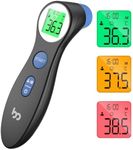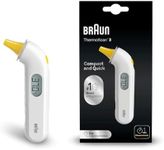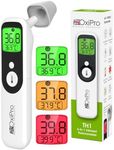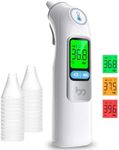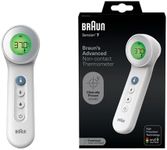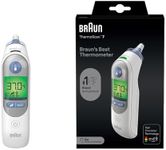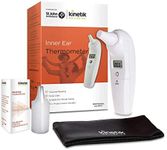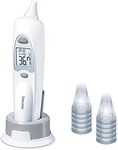Buying Guide for the Best Thermometers
Choosing the right thermometer is essential for accurately monitoring body temperature, which is crucial for managing health. There are various types of thermometers available, each with its own set of features and specifications. Understanding these key specifications will help you select the best thermometer for your needs.TypeThermometers come in several types, including digital, infrared, and mercury. Digital thermometers are the most common and are known for their accuracy and ease of use. Infrared thermometers are non-contact and can measure temperature from the forehead or ear, making them ideal for children. Mercury thermometers are less common due to safety concerns but are still used for their reliability. Choose the type based on your preference for ease of use, safety, and the specific needs of the person being monitored.
AccuracyAccuracy is crucial when it comes to thermometers, as even a small discrepancy can affect health decisions. Most digital and infrared thermometers offer high accuracy, typically within 0.1 to 0.2 degrees Celsius. For general use, a thermometer with an accuracy of ±0.2 degrees Celsius is sufficient. If you need more precise measurements, such as for medical conditions, look for a thermometer with higher accuracy.
Response TimeResponse time refers to how quickly the thermometer provides a reading. Digital thermometers usually take between 10 to 30 seconds, while infrared thermometers can give a reading almost instantly. Faster response times are particularly useful for taking the temperature of children or multiple people in quick succession. Choose a thermometer with a response time that matches your need for speed and convenience.
Ease of UseEase of use encompasses how simple and intuitive the thermometer is to operate. Features like a large, easy-to-read display, simple button controls, and clear instructions contribute to ease of use. Consider who will be using the thermometer; for example, a user-friendly design is especially important for elderly individuals or those with limited technical skills.
Memory FunctionSome thermometers come with a memory function that stores previous readings. This feature is useful for tracking temperature changes over time, which can be important for monitoring illnesses. The number of readings stored can vary, with some thermometers storing up to 20 readings. If you need to keep a record of temperature readings, look for a thermometer with a memory function.
Measurement UnitsThermometers can display temperature in either Celsius or Fahrenheit. Some models allow you to switch between the two units. Choose a thermometer that displays the unit you are most comfortable with or one that allows you to switch units if needed.
Hygiene and MaintenanceHygiene is particularly important for thermometers, especially if they are used by multiple people. Look for thermometers with features like disposable probe covers or easy-to-clean surfaces. Infrared thermometers are generally more hygienic as they do not require contact with the skin. Consider how easy it is to maintain the thermometer to ensure it remains clean and functional.
Battery LifeBattery life is an important consideration, especially for digital and infrared thermometers. Longer battery life means less frequent replacements and more reliable performance. Some thermometers come with a low battery indicator to alert you when it's time to change the battery. Choose a thermometer with a battery life that suits your usage frequency.
